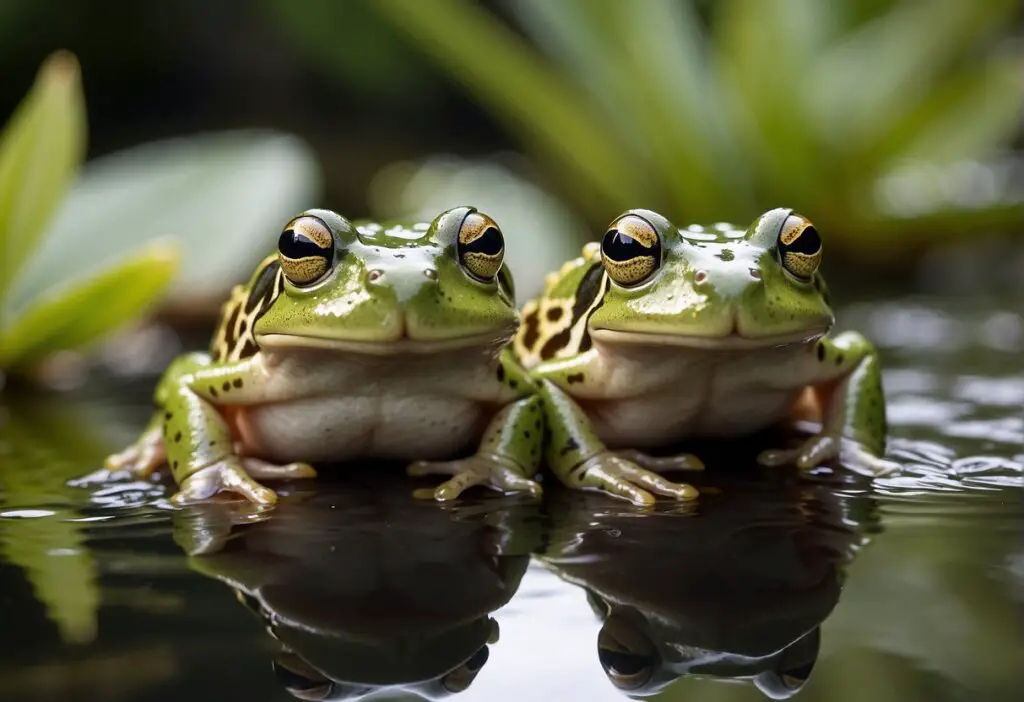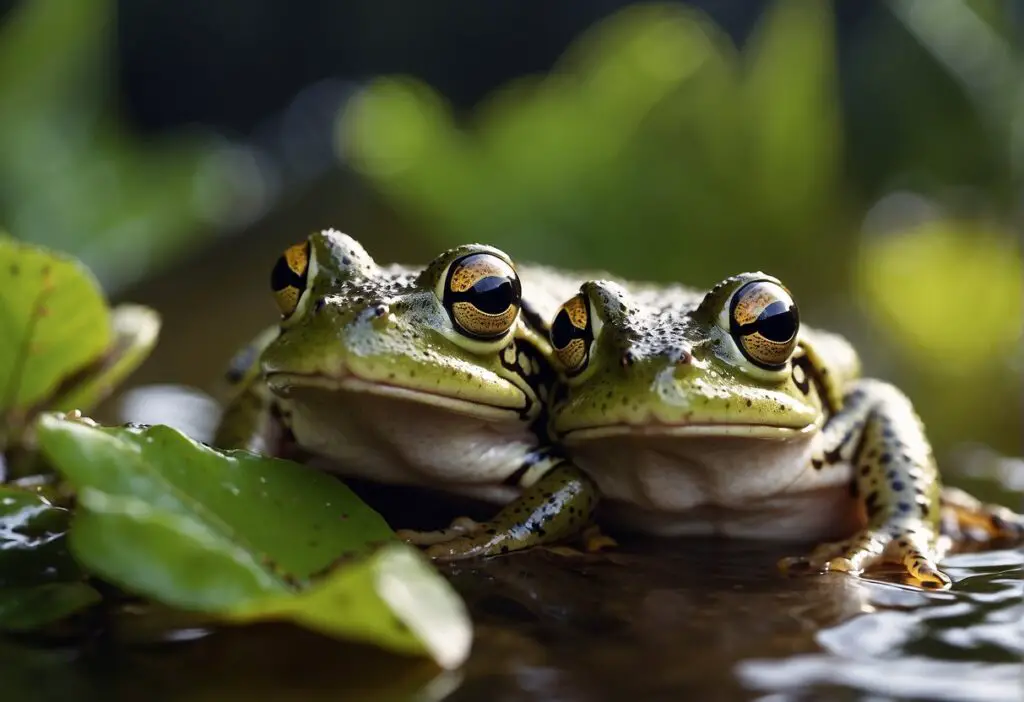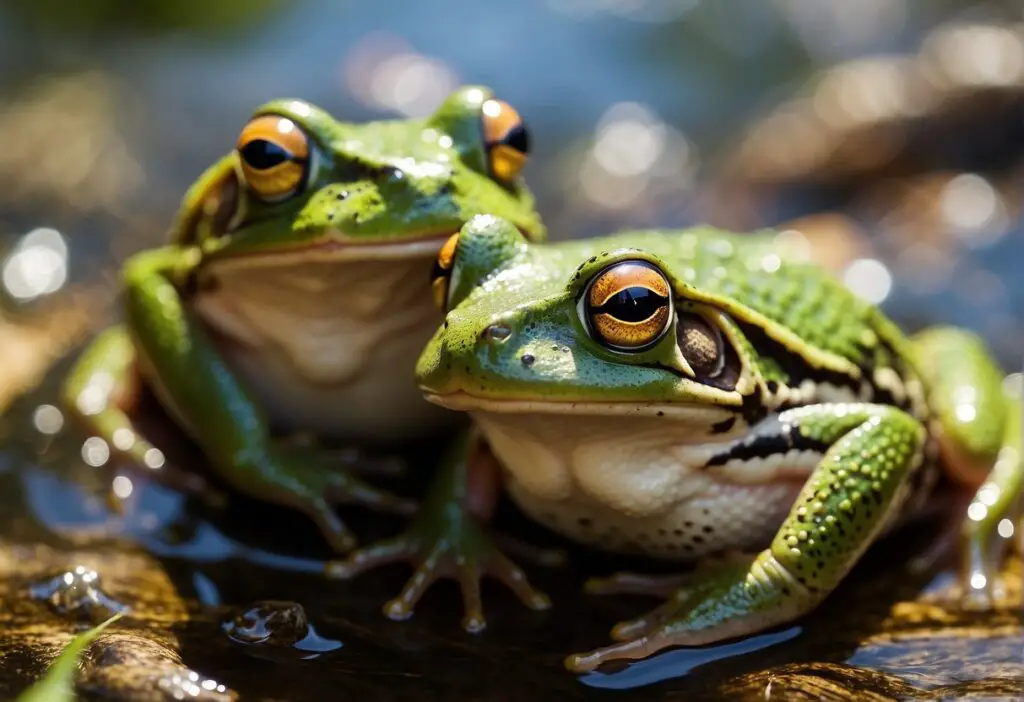Amplexus is a term used to describe the mating position of frogs. This reproductive position is used by the vast majority of frog species for external reproduction. During amplexus, the male clasps the female from the back, stimulating the female to release eggs, which the male then fertilizes.

Understanding amplexus is crucial to understanding the mating process of frogs. There are ten known amplexus positions, and the duration of the process can vary from a few hours to several days. Amplexus is a fascinating aspect of frog behavior and anatomy and plays a significant role in the fertilization and reproduction of these amphibians.
Key Takeaways
- Amplexus is the term used to describe the mating position of frogs.
- It is a crucial aspect of the mating process of frogs, and the vast majority of frog species use it for external reproduction.
- Amplexus plays a significant role in the fertilization and reproduction of these amphibians.
Understanding Amplexus
Definition and Etymology
If you’re interested in learning about frog mating behaviors, you’ve likely come across the term “amplexus.” But what exactly is amplexus, and where does the word come from?
Amplexus is a reproductive position used by frogs, where the male grasps the female with his front legs as part of the mating process. The word “amplexus” comes from the Latin word for “embrace,” which is fitting given the way the male frog wraps his arms around the female.
Amplexus Versus Other Mating Behaviors
While amplexus is the most common mating behavior used by frogs, it’s important to note that not all frog species use this position. Some species, such as those in the genus Pipa, have evolved alternative mating behaviors that don’t involve amplexus.
In addition to frogs, other species such as horseshoe crabs also exhibit amplexus as part of their mating behavior. However, the specifics of the behavior can vary between species.
The Mating Process
Frogs are known for their unique mating process, which involves a position called amplexus. In this section, we’ll look at how this process works and what you need to know about it.
http://www.youtube.com/watch?v=rw6s8lsh0EQ
Initiation of Amplexus
The mating process in frogs begins when the male frog initiates amplexus, which is when he grasps the female frog with his front legs. This is done to hold the female in place during mating and to stimulate the release of eggs.
Types of Amplexus
There are several different types of amplexus that male frogs can use during the mating process. The most common type involves the male grasping the female around the torso with his forelimbs. Other types of amplexus include inguinal amplexus, axillary amplexus, and more.
Duration and Timing
The duration of amplexus can vary depending on the species of frog and the type of amplexus being used. Some species may only mate for a few hours, while others may mate for several days. The timing of the mating process can also vary depending on the climate and breeding season. In temperate climates, mating typically occurs in the spring, while in some climates, it may occur during monsoon or rainy seasons.
Anatomy and Physiology
When it comes to amplexus in frogs, there are certain adaptations that are crucial for the process to occur.
Adaptations for Amplexus
The male frog has adapted his forelimbs to be able to grasp the female during amplexus. These limbs are longer and more muscular than those of the female frog, allowing him to hold on tightly and prevent her from escaping.
In addition, male frogs often have nuptial pads on their thumbs during breeding season. These pads are rough and help the male to grip onto the female’s skin more securely during amplexus.
The female frog’s cloaca is also adapted for amplexus. This is the opening through which both urine and eggs are expelled. During amplexus, the male frog will release sperm into the female’s cloaca, where it will fertilize the eggs as they are released.
Sexual Dimorphism
There is often sexual dimorphism in frogs, with males being larger and having more colorful markings than females. This is likely due to sexual selection, as females may be more attracted to males with these traits.
During amplexus, the male frog will often clasp the female from behind, stimulating her to release eggs. The male will then fertilize these eggs with his sperm, and the female will lay them in a suitable location for development.
Amplexus Across Species
Amplexus is a mating behavior exhibited by some externally fertilizing species, chiefly amphibians and horseshoe crabs. But what about frogs and toads?
Variations in Frogs and Toads
In frogs, amplexus is a behavior where the male grasps the female with his front legs as part of the mating process. The male clasps the female to stimulate the release of her eggs. Once she starts to release her eggs, the male begins fertilizing each one with sperm cells. The fertilized eggs then develop into tadpoles.
Toads, on the other hand, have a slightly different variation of amplexus. During mating, the male toad grasps the female tightly around the chest with his front legs. This is known as axillary amplexus. The male toad then releases sperm on the eggs as they are laid by the female.
Comparison with Other Amphibians
Amplexus is not unique to frogs and toads. Other amphibians such as salamanders and newts also exhibit this behavior. However, the position in which the male grasps the female may differ. In some species, the male grasps the female around the waist, while in others, the male grasps the female around the head.
Amplexus is also not limited to amphibians. Some fish, reptiles, and birds also exhibit this behavior. In fish, the male fertilizes the female’s eggs as they are released into the water. In reptiles, the male grips the female’s neck with his jaws during mating. In birds, the male mounts the female and grasps her with his claws during copulation.
Fertilization and Reproduction
Frogs reproduce through a process called amplexus, which is a reproductive position used by frogs to replicate externally. During amplexus, the male frog clasps the female from the back using his front legs. This position allows the male to fertilize the eggs as they are released by the female. The fertilization process involves the release of sperm into the water, where it meets the eggs.

External Versus Internal Fertilization
Frogs are an example of an animal that uses external fertilization to reproduce. This means that fertilization occurs outside of the female’s body. In contrast, internal fertilization occurs inside the female’s body. Internal fertilization is used by mammals, including humans, as well as some reptiles and birds.
Egg Laying and Development
After fertilization, the female frog will lay her eggs in a suitable location, such as in water or on land. The eggs will then hatch into tadpoles, which will eventually develop into adult frogs. The process of laying eggs is called oviposition, and it is an essential part of the frog’s life cycle.
Frog eggs are typically laid in clumps, and they are surrounded by a gel-like substance that protects them from predators and helps to keep them moist. The eggs will hatch after a few days or weeks, depending on the species of frog and the environmental conditions.
During the tadpole stage, the young frogs will undergo a process of metamorphosis, during which they will develop legs and lungs. This process can take several weeks or months, depending on the species of frog and the environmental conditions.
Behavioral Aspects
When it comes to the behavior of frogs, amplexus is a crucial aspect of their mating process. This reproductive position is used by most frog species for external reproduction, and it involves the male clasping the female from behind. In this section, we will explore the behavioral aspects of amplexus, including courtship, mating calls, mate selection, and competition.
Courtship and Mating Calls
Before mating, frogs engage in courtship behavior, which involves a series of vocalizations and physical displays. Male frogs use mating calls to attract females, and each species has a unique call that distinguishes it from others. For example, the American bullfrog produces a deep, resonant croak, while the spring peeper produces a high-pitched chirping sound.
Mate Selection and Competition
Mate selection and competition are also important aspects of frog behavior during amplexus. Female frogs are often outnumbered by males, and as a result, males will compete for access to females. This competition can take the form of aggressive behavior, such as wrestling or biting, or it can be more subtle, such as producing more attractive mating calls.
Sexual selection also plays a role in mate selection, as females will choose mates based on certain traits, such as size, coloration, or vocalizations. This process can lead to the formation of mating balls, where multiple males will attempt to mate with a single female. In some cases, the female may reject all of the males and choose a different mate.
Environmental Influences
Amplexus is a reproductive position used by frogs to replicate externally. However, environmental conditions such as habitat, climate, and seasonality play a crucial role in the breeding cycle of these amphibians. Let’s take a closer look at how these factors influence the mating behavior of frogs.
Habitat and Climate
Frogs prefer freshwater habitats such as ponds, lakes, swamps, and puddles. These areas provide a suitable environment for the development of fertilized eggs. Additionally, shaded and slow-moving bodies of water are ideal for amplexus. The northern hemisphere is home to many frog species that mate during the spring and summer months when temperatures are warmer.
Seasonality and Breeding Cycles
Frogs typically reproduce once a year during the breeding season. This period varies depending on the species and location. For example, some frogs in the northern hemisphere breed from March to June, while others in tropical regions breed year-round. During the breeding season, males use their calls to attract females for amplexus. Once they find a mate, the male clasps the female from behind and fertilizes her eggs as she lays them.
Conservation and Study
Frogs are important members of the ecosystem and have significant roles in pest control, nutrient cycling, and disease control. Therefore, it is crucial to conserve them and their habitats. Amplexus, the mating position of frogs, is an important aspect of their reproductive process that requires attention in conservation efforts.

Amplexus in Research
Researchers have studied amplexus in frogs to understand their mating behaviors and reproductive biology. By observing the mating process, scientists can learn about the species’ breeding habits, fertilization, and development of offspring. For example, the duration of amplexus varies from species to species, with some lasting a few hours and others lasting several days.
Threats to Mating Habitats
Habitat loss and pollution are significant threats to the survival of frog species and their mating habitats. Many frogs rely on aquatic environments for reproduction, and degradation of these habitats can lead to a decline in populations. Pesticides and other pollutants can also harm frogs and their mating behaviors. Conservation efforts to protect mating habitats and reduce pollution are necessary to ensure the survival of frog species.
Frequently Asked Questions
What role does amplexus play in frog reproduction?
Amplexus, a mating behavior observed in frogs, plays a crucial role in the reproductive process. During amplexus, the male frog grasps the female from behind, usually around the waist or the armpits, and holds on tight. This position allows the male to fertilize the eggs as they are laid, ensuring successful reproduction.
How does amplexus facilitate fertilization in amphibians?
Amplexus facilitates fertilization in amphibians by bringing the male and female reproductive organs in close proximity. As the female lays her eggs, the male releases his sperm, which fertilizes the eggs externally. This process is called external fertilization and is only possible when the male is in the amplexus position.
Can you describe the different types of amplexus observed in frogs?
There are two main types of amplexus observed in frogs: axillary amplexus and inguinal amplexus. In axillary amplexus, the male grasps the female around the armpits, while in inguinal amplexus, the male grasps the female around the waist. Some species of frogs also exhibit dorsal straddle amplexus, where the male straddles the female’s back.
What is the duration of amplexus in frog mating behavior?
The duration of amplexus in frog mating behavior varies depending on the species. Some species can remain in the amplexus position for several hours, while others only stay in the position for a few minutes. The duration of amplexus is influenced by factors such as the size of the female, the size of the male, and the number of eggs being laid.
In frog behavior, what does the term ‘amplexing’ refer to?
The term ‘amplexing’ refers to the act of grasping the female during amplexus. This term is commonly used to describe the mating behavior of frogs and is often used interchangeably with the term ‘amplexus.’
What are the observable differences between amplexus in frogs and similar behaviors in other species?
Amplexus in frogs is similar to mating behaviors observed in other species, such as toads and newts. However, there are some observable differences between amplexus in frogs and other species. For example, in toads, the male grasps the female around the head, while in newts, the male grasps the female around the waist. Additionally, some species of frogs exhibit unique mating behaviors, such as the male carrying the female on his back during mating.

